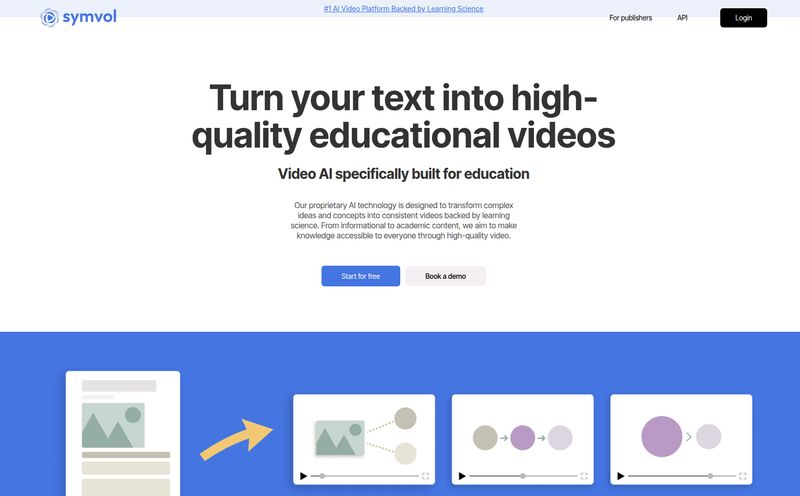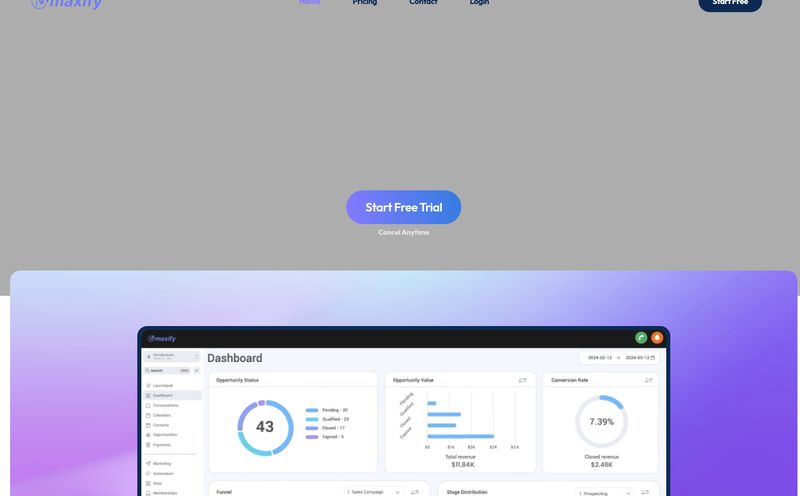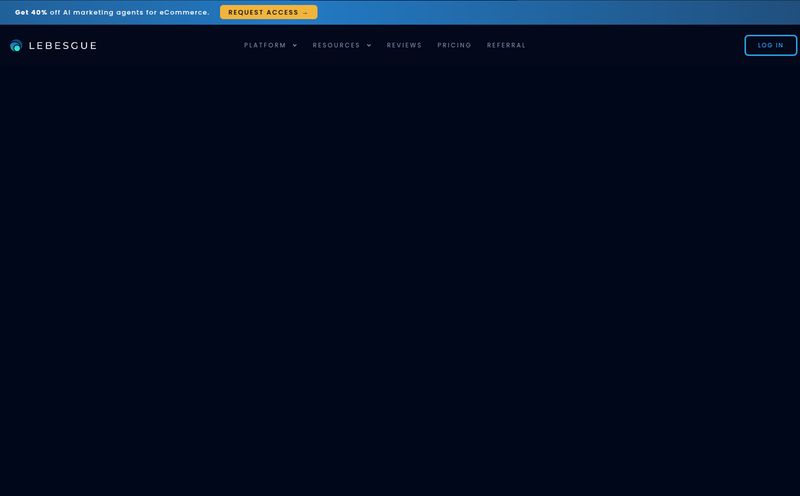We're all on this content treadmill, churning out posts, emails, and social updates, but the one thing that consistently moves the needle—and also happens to be the biggest pain to produce—is video. Video. It's everywhere. And the demand for it is just relentless.
For years, I've watched marketing teams, including my own, get bogged down in the video production swamp. The endless back-and-forth with videographers, the budget black holes, the weeks spent on what ends up being a 45-second clip for LinkedIn... It’s exhausting. We all know we need more video, but who has the time or the cash?
So, when a tool like Storykit pops up on my radar, claiming it can help teams create 200% more video with 95% less budget, my seasoned-marketer-skepticism-meter goes off. But so does my curiosity. An AI video creation tool that turns simple text into high-quality, on-brand video? Okay, you have my attention. I decided to take a closer look.
So, What Exactly is Storykit?
At its core, Storykit is a video automation platform. It's built for organizations that need to scale their video content without scaling their production team or budget. The main hook is its powerful text-to-video AI. You feed it a script, a blog post, or even just a few bullet points, and it automates the creation of a video from that text.
Think about that for a second. All those press releases, internal announcements, blog articles, and case studies sitting in your content library? Storykit sees them as a goldmine of potential video assets. It’s designed to be the bridge between your existing text-based content and the high-engagement world of video. It's less about being a flashy, one-off video editor and more about becoming an integral part of your content workflow. A machine that constantly turns words into moving pictures. A pretty compelling idea, right?

Visit Storykit
My First Impressions and Why Video Automation Matters
Logging in, the platform feels clean and professional. It's not trying to be TikTok or CapCut. It has a serious, business-first vibe, which makes sense given its target audience is likely marketing departments and communications teams, not solo creators. The whole concept hinges on efficiency.
And let's talk about that for a moment. Video automation isn't just a buzzword; it's a response to a very real problem. Traditional video creation is linear and slow. Scripting, storyboarding, shooting/sourcing footage, editing, adding graphics, getting approvals... it's a process. Storykit aims to make it parallel. It’s like having a junior video editor on standby 24/7, ready to assemble a first draft the second you give it the script. This isn’t about replacing your high-concept brand films; it’s about conquering the day-to-day video needs that eat up so much time.
Digging Into the Features That Caught My Eye
Beyond the main premise, a few features stood out to me as particularly smart and well-thought-out for a professional setting.
The Magic of Text-to-Video AI
This is the heart of Storykit. You input your text, and the AI gets to work. It analyzes the text to understand the story, suggests visuals from its library (or your own uploaded assets), and automatically times the scenes and text overlays. It's not just slapping words on a random video background. It tries to create a coherent narrative. Of course, you can—and should—go in and tweak its suggestions, but the heavy lifting is done for you. This dramatically lowers the barrier to entry. No more staring at a blank timeline in Adobe Premiere Pro wondering where to even begin.
Keeping it On-Brand with Customization
This is huge. One of my biggest gripes with many template-based video tools is how generic the output can feel. Storykit seems to get this. It allows for deep customization to ensure every video looks and feels like your brand. You can set up your brand kit with specific fonts, colors, logos, and branded graphic elements. Once it's set, every video you create will automatically adhere to these guidelines. This ensures brand consistency, which is music to the ears of any brand manager. It prevents the dreaded 'Frankenstein's monster' of content, where every video looks like it came from a different company.
Speaking Their Language (Literally)
The platform’s support for multiple languages is another massive plus for any international organization. You can create a video in one language and then, with a few clicks, generate versions for different regions. Anyone who's ever managed multi-language content knows how time-consuming and error-prone this can be. Automating this process saves not just time but also a ton of coordination headaches.
Plays Well with Others via API Integration
For the tech-savvy teams, the inclusion of an API is a sign that Storykit is serious about workflow integration. This means you can connect Storykit to your existing tools—your CMS, your DAM (Digital Asset Management system), whatever. You could, for example, set up an automation where every time a new blog post is published, a draft video is automatically created in Storykit. That's moving from simple content creation to building a true content engine.
The Big Question: Can It Really Save You Time and Money?
So, back to that bold claim: 200% more video for 95% less budget. Is it just marketing fluff? Well, yes and no. The numbers are obviously an ideal-case scenario, but the principle behind them is sound. Where you save is by drastically cutting down on man-hours and the need for specialized skills. You no longer need an expert video editor for every single social clip or announcement. Your copywriter or content manager can now be your video creator. This efficiency boost means your team can produce a higher volume of content in the same amount of time. Instead of one polished video a month, maybe you can now produce that one plus eight social clips, two internal updates, and a video version of your latest case study. So yes, the potential to increase output while streamlining costs is definitely there. You're trading a high per-video cost for a fixed subscription fee, which can be a massive win if you have a high-volume need.
What's the Catch? A Look at the Potential Downsides
No tool is perfect, of course. For all its strengths, Storykit isn't a silver bullet for every video need. The most obvious 'catch' is that this is a professional-grade tool with a price tag to match. You won't find a pricing page on their site; it’s all “Book a Demo,” which usually means custom enterprise-level pricing. This isn't a tool you'll pick up for a fiver a month. It's an investment for businesses that are serious about scaling video.
Another point to consider is that some of the most powerful features, like that juicy API integration, are likely reserved for the higher-tier Pro and Enterprise plans. This is standard practice in SaaS, but it’s something to be aware of. You need to be sure the plan you're considering has the specific tools you need.
Finally, while the AI is impressive, it's not going to produce a creatively groundbreaking, award-winning brand film. It’s a tool for creating clean, professional, and effective informational video content at scale. Think of it as a high-end Toyota, not a temperamental Ferrari. It’s reliable and gets the job done efficiently, but you dont take it to the Monaco Grand Prix.
Who is Storykit Actually For?
After spending some time with it, the ideal user profile for Storykit becomes pretty clear. It's not for the solo YouTuber or the aspiring filmmaker.
Storykit is built for:
- Corporate Communications Teams: Perfect for quickly turning press releases, internal announcements, and CEO messages into shareable videos.
- Marketing Departments: A godsend for content marketing teams who want to repurpose blog posts, create social media videos, and produce video ads without a huge production cycle.
- Publishers and Media Houses: Great for turning articles into video summaries to increase engagement on their websites and social channels.
If you're in an organization that has a constant, nagging need for more video content for communication, marketing, or HR, Storykit could genuinely change the way you work.
Frequently Asked Questions About Storykit
How does Storykit's AI work?
The AI analyzes your script or text to identify key themes and structure. It then automatically matches your text with stock video footage, images, and icons from its library (or your own uploaded assets), creates scenes, and times the on-screen text and animations to create a cohesive video draft.
Do I need video editing experience to use Storykit?
Absolutely not. That’s one of its main selling points. It's designed for communicators, writers, and marketers, not professional video editors. The interface is intuitive, and the AI handles the technical aspects of video creation.
What about music and stock footage?
Yes, platforms like Storykit typically come with an extensive built-in library of royalty-free stock videos, images, and music tracks. This is crucial for creating professional-looking videos without worrying about copyright issues or extra licensing fees.
Is Storykit good for social media videos?
Definitely. It's a great tool for creating the kind of short-form, text-heavy videos that perform well on platforms like LinkedIn, Facebook, and Instagram. You can easily create videos in different aspect ratios (square, vertical, horizontal) to fit the requirements of each platform.
How much does Storykit cost?
Storykit doesn't list public pricing on their website. Their model is targeted at businesses and enterprises, so pricing is likely customized based on your team's size, usage needs, and the features required. You'll need to contact their sales team or book a demo to get a quote.
Can I integrate Storykit with my existing workflow?
Yes, through their API (available on higher-tier plans). This allows for powerful integrations with your Content Management System (CMS), Digital Asset Management (DAM), or other marketing automation tools to streamline your content pipeline.
My Final Verdict on Storykit
So, am I a convert? I have to say, I’m pretty impressed. Storykit isn't just another video editor. It's a strategic tool designed to solve a specific and painful problem for a lot of businesses: the video content bottleneck. It’s a smart, efficient platform that empowers teams to do more with less.
It won't replace your creative agency for that big Super Bowl ad, but it was never meant to. What it will do is empower your team to finally meet the daily, weekly, and monthly demand for video content in a way that’s fast, on-brand, and scalable. For any organization struggling to keep up with the video revolution, taking a look at Storykit might be one of the smartest things you do this year. It might just be the tool that gets you off the content treadmill and into the fast lane.
Reference and Sources
- Storykit Official Website
- To add context on video marketing's effectiveness, you might check out reports from sources like the Wyzowl State of Video Marketing report.



